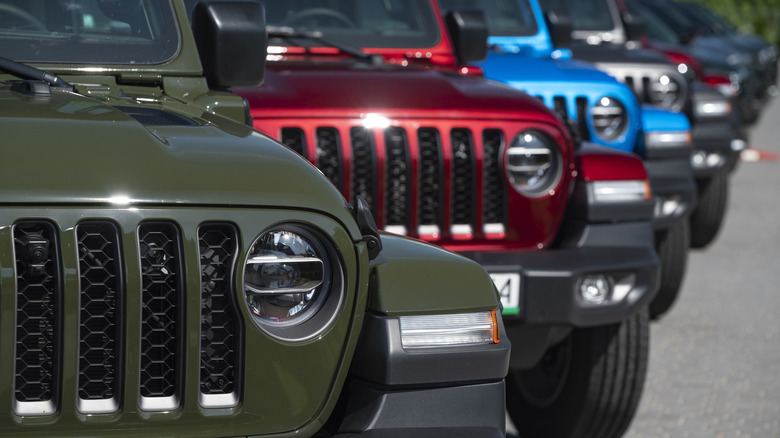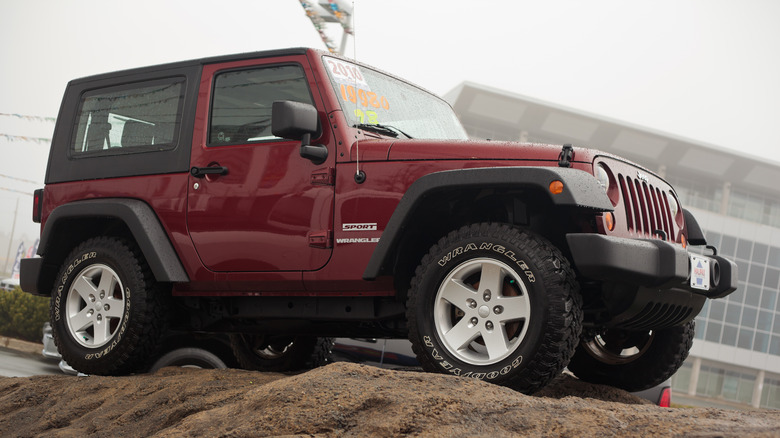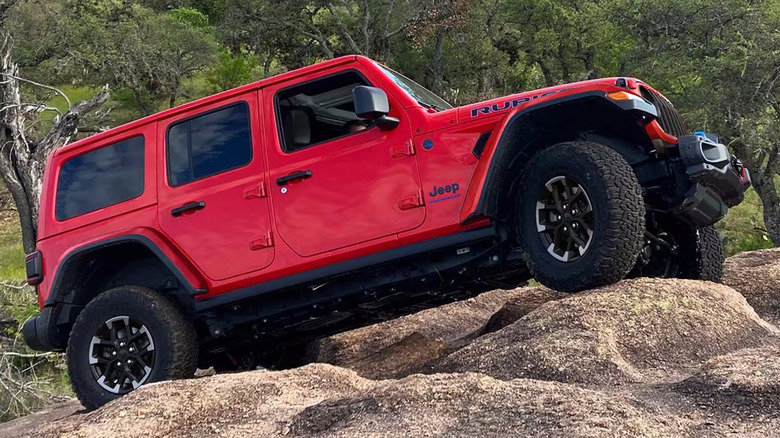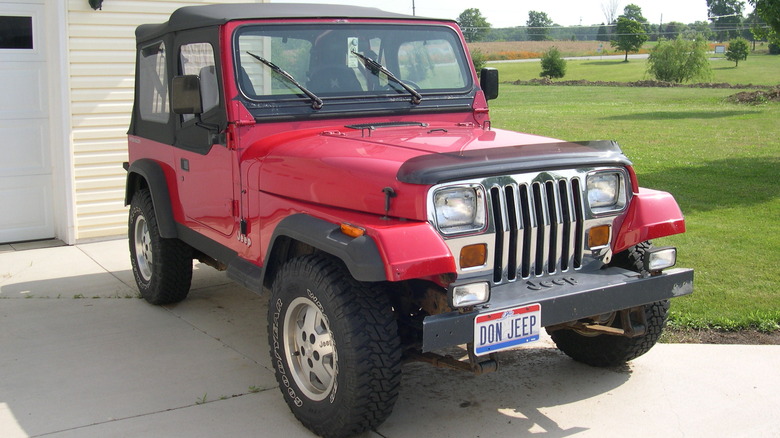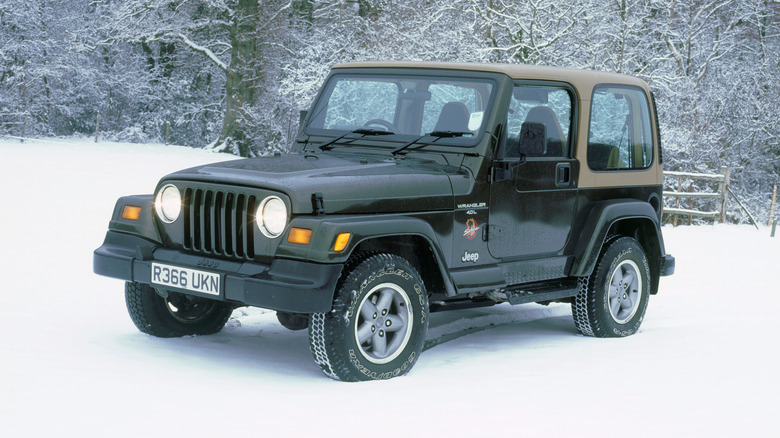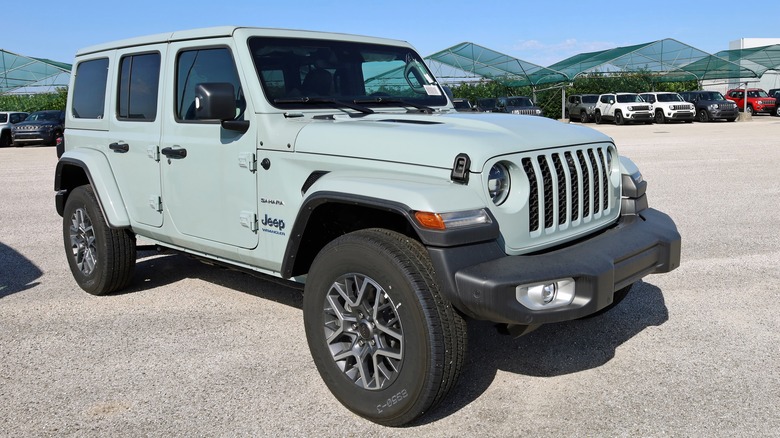Every Generation Of Jeep Wrangler, Ranked Worst To Best
When most people think of the Jeep brand, the model that comes to mind is the Wrangler and not one of the brand's other models like the Grand Cherokee, Compass, or Renegade. The Wrangler was introduced as a replacement for the CJ-7 when Chrysler bought the Jeep brand along with the rest of AMC's holdings in 1987.
The CJ-7 was the last in a long line of CJs that began with the CJ-2A, which was produced from 1945 through 1949. That model sprung from the Quad that Willys Overland built for the U.S. Army during World War II. The Wrangler is nearing its 40th birthday and has seen the gradual implementation of features like fuel injection, airbags, and quick-release modular hardtop panels over its four generations. With its evolution, the Wrangler has also seen dramatic changes in the available powertrains and the current model has a tenuous connection to the first-generation YJ model. Here is our ranking of the four distinct Jeep Wrangler generations based on reliability, comfort, and available features.
4. JK (2007-2017)
To some Jeep enthusiasts, the JK model designation used for the third-generation Wrangler made between 2007 and 2017 stands for "just kidding." That's not to say the third-gen Wrangler was a complete joke, but it did have issues that weren't seen in the previous two generations. The JK's new 'Freedom panel' modular top system was prone to leaks where the front doors and overhead panels met. There was no rubber weatherstripping on the body side around the door openings, so gaps opened up above and around the doors when the roof panels became misaligned due to vibration.
The JK era also saw the end of the line for Jeep's legendary 4.0-liter inline six-cylinder engine. This motor ranked eighth on SlashGear's list of the auto industry's most reliable inline sixes ever and was replaced in 2007 by a 3.8 liter V6 that doesn't enjoy nearly as favorable a reputation as the 4.0. The 3.8's torque peak also came at a higher rpm range, making it less suited for off-road use. Motor Trend cites several design issues with the 3.8 liter V6, including excessive oil consumption, a crack-prone exhaust manifold, and substandard piston rings. These issues often limited the JK engine's operating life to about 100,000 miles, which is about the point where the 4.0 was just getting broken in.
The 2017 model was the subject of five separate recalls, and the NHTSA logged nearly 250 complaints from owners, including issues with the engine, steering, and seat belts.
3. JL (2018-present)
The latest generation of the Wrangler, the JL, premiered for the 2018 model year. An optional 2.0-liter turbocharged four-cylinder engine was available as an option. This engine had a mild hybrid e-assist, which boosted fuel economy to a respectable 23 mpg city and 25 highway. The turbo four also offered 295 pound-feet of torque vs. the V6's 260, which made the smaller engine a more capable powerplant for rock-crawling or mudding. For 2019, a beefier 3.0-liter eco-diesel was offered, which produced 442 pound-feet of torque. Off-road optimized Rubicon models have locking front and rear differentials, a front sway bar disconnect for better articulation over uneven terrain, and a 4:1 low-range transfer case.
The JL offered some creature comforts previously unseen in a Wrangler: an Apple CarPlay and Android Auto-ready touchscreen, Wifi hotspot, and backup camera. Emme Hall of CNET was pleased with the Wrangler's new engine options and off-road chops but admitted that " driving a Jeep on the pavement is, well, like driving a Jeep on the pavement. The solid front and rear axles mean it's not going to win any comfort contests." The current JK lineup includes the plug-in hybrid Wrangler 4xe and Wrangler Rubicon 392, which is powered by a 470-horsepower Hemi V8.
2. YJ (1987-1995)
The original YJ Wrangler offended many Jeep purists with its rectangular headlights, but the YJ has stood tall for nearly four decades since it became the first model to wear the Wrangler badge. The YJ was initially offered with either a notoriously reliable 2.5-liter four-cylinder or the 4.2-liter I6 that was the predecessor to the equally revered 4.0. The transition from the carbureted 4.2 to the fuel-injected 4.0 came for the 1991 model year, four years after the 4.0 debuted in the XJ Cherokee.
YJ Wranglers commonly run for 200,000 miles or more and remain surprisingly affordable on the secondhand market. Early manual transmission YJs had a problematic hydraulic throwout bearing, but in 1994, it was replaced by an externally mounted secondary cylinder. Beginning in 1988, all YJs got the tough-as-nails New Process 231 transfer case, and Pete Trasborg of Motor Trend calls the YJ Wrangler "a great Jeep and a good platform to start off with" based on its reliable drivetrain and relative affordability, especially if you can look past the hideous plastic dashboard.
1. TJ (1997-2006)
The best of the four generations of Wrangler is the TJ, which took over from the YJ in 1997 after the badge took a one-year hiatus for its first major update. The TJ saw a return to round headlights, which delighted hardcore fans. Initially, the 2.5-liter I4 and 4.0-liter I6 were carried over from the YJ to the TJ, but the PowerTech 2.4-liter four-cylinder replaced the 2.5 starting in 2003. The 4.0-liter six-cylinder engine stayed with the Wrangler until the TJ gave way to the JK. The persistence of Jeep's two stalwart engines helped earn the second-generation Wrangler top billing here, but the TJ also saw the Wrangler get some warmly welcomed safety and comfort updates.
The TJ was the first Wrangler to get airbags, in keeping with a 1991 law that mandated all vehicles have them by 1998. The YJ's rough-riding leaf spring suspension was ditched in favor of a more posterior-friendly four-link coil spring system. Although the TJ had excellent road manners, it remained a capable off-road warrior. The frame and body were stiffer than the YJ's, and the Rubicon submodel made its first appearance in 2003. The next year, Jeep introduced the TJ Unlimited, or LJ, for "long Jeep." This version had a wheelbase 15 inches longer than standard TJs, making the LJ more comfortable and a more capable towing rig. Two of those inches were added at the driver's feet, and the rest went in back for additional cargo.
Methodology
To rank every generation of Jeep Wrangler, we carefully researched each of the four in terms of the reliability of drivetrain components and documented issues. I began with personal knowledge gained from owning and maintaining five Wranglers over the past 30 years (three YJs, one TJ, and one JK.)
I then combined existing reviews and commentary via reputable outlets like Motor Trend and Driving Line with SlashGear's previous reporting on Jeep engines and reviews for the current models to round out the research and finalize this list. Close attention was paid to the reliability and performance of the engines in each generation of Wrangler as well as quality of construction, and credit was given where important comfort and safety features were added to the Wrangler.
